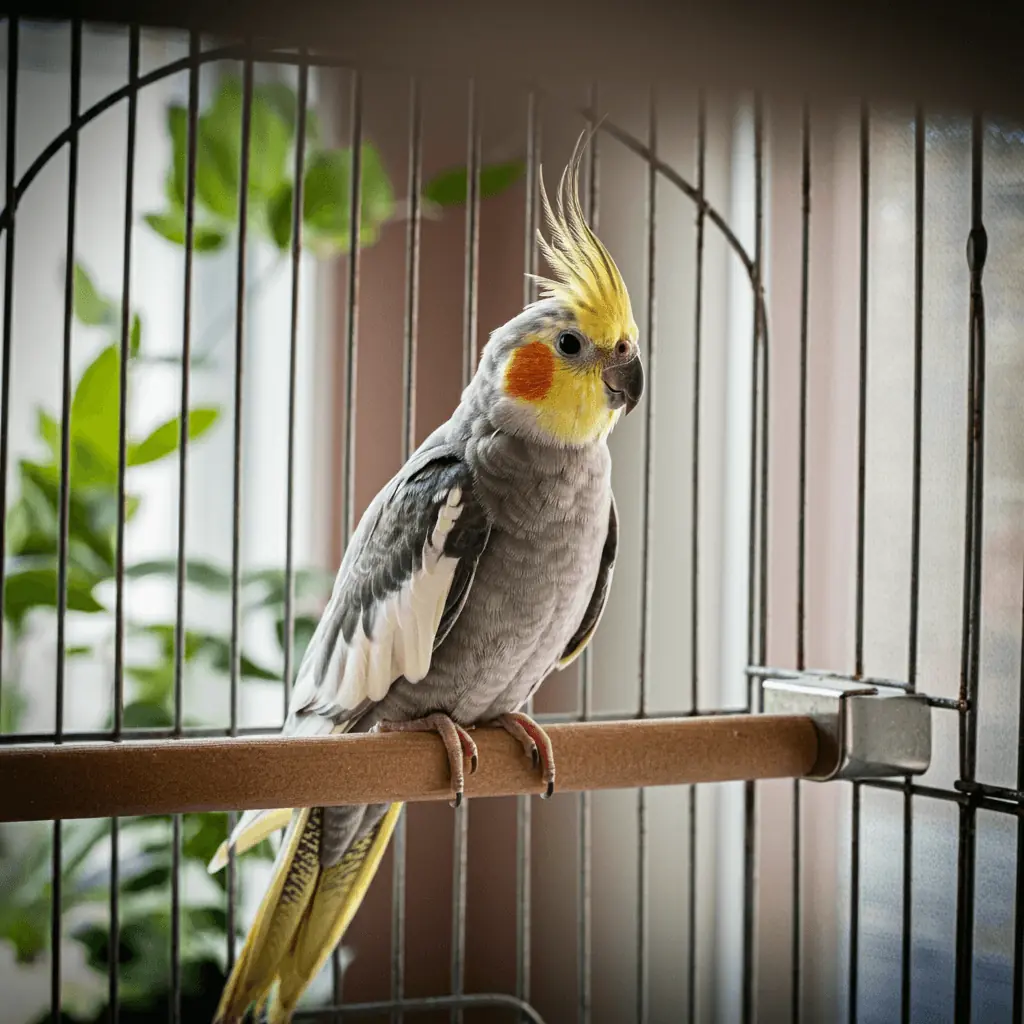Introduction to Cockatiel Grooming
Grooming is an essential part of keeping your cockatiel healthy and happy. Like all birds, cockatiels need regular care to maintain their feathers, nails, beak, and overall hygiene. Proper cockatiel grooming not only keeps them looking great but also prevents potential health problems down the line, such as overgrown nails, dirty feathers, or beak issues.
If you’re new to grooming your cockatiel at home, you might feel a bit overwhelmed. But don’t worry! With the right approach and some basic grooming tools, you can easily take care of your bird’s grooming needs. This guide will walk you through the essentials of cockatiel grooming, ensuring that your feathered friend stays clean, comfortable, and healthy.
Regular grooming includes more than just trimming nails or bathing your cockatiel safely—it also involves keeping an eye on their feathers, ensuring their beak is healthy, and even maintaining a clean living environment. A clean cage is just as important as direct grooming because it contributes to your cockatiel’s overall hygiene and well-being.
By following these simple grooming tips for cockatiels, you’ll build a bond with your bird and give them the care they need to thrive. Whether you’re a beginner or a seasoned bird owner, this grooming guide is designed to provide practical, easy-to-follow advice that you can start using today.
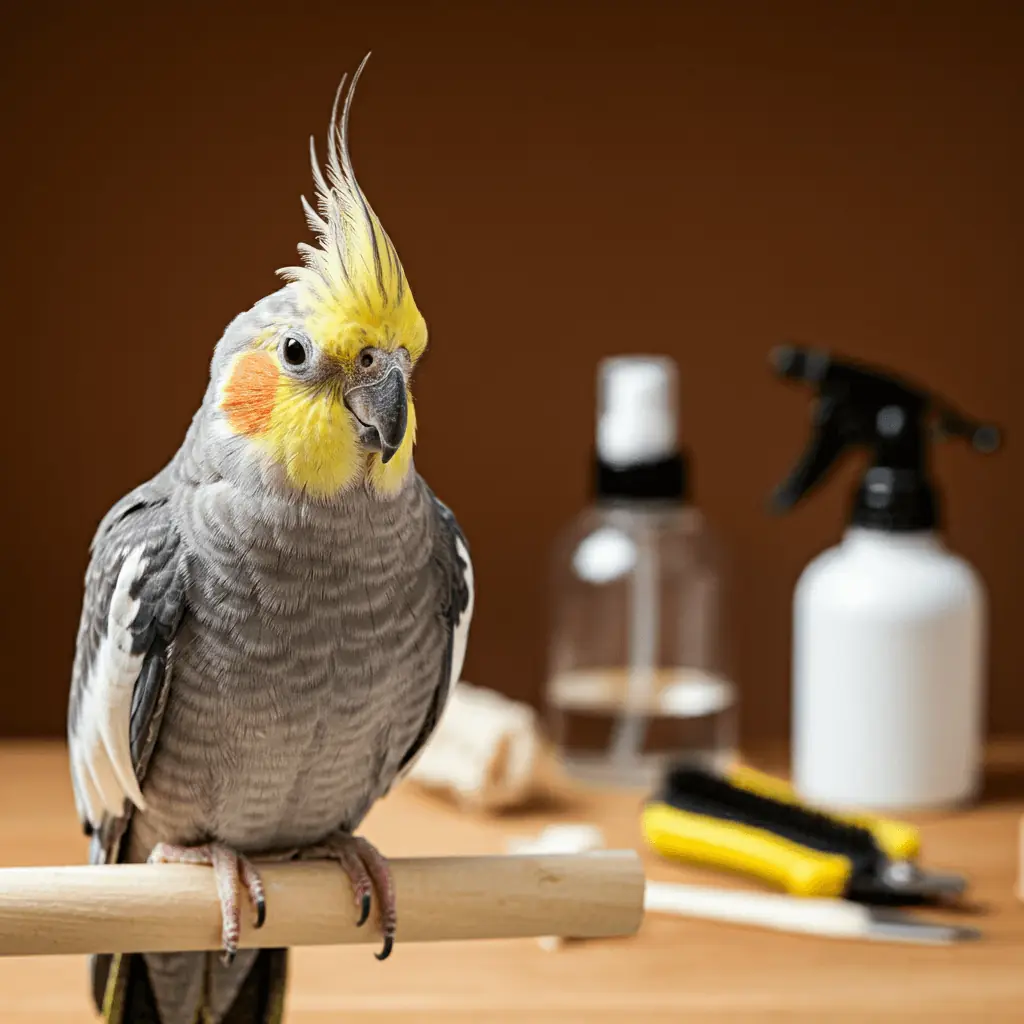
A healthy cockatiel sits comfortably on a perch with grooming tools in the background, ready for a care session.
Why Grooming Is Important for Your Cockatiel
Grooming plays a crucial role in maintaining the health and well-being of your cockatiel. It’s not just about keeping your bird looking clean—regular grooming helps prevent health issues that can arise if their nails, beak, or feathers aren’t properly maintained. By keeping your cockatiel groomed, you’re ensuring they remain comfortable, mobile, and in top condition.
For example, overgrown nails can make it difficult for your cockatiel to grip perches properly, leading to discomfort or even injury. Similarly, without proper beak maintenance, a cockatiel’s beak can become overgrown or misaligned, which affects their ability to eat and groom themselves. Grooming also ensures that your bird’s feathers are in good shape, helping them with insulation, flying, and overall movement.
Another critical aspect of grooming is that it allows you to regularly check for signs of health problems. By handling your bird, you’ll be able to spot issues like feather damage, skin irritation, or parasites early on. This proactive care can prevent more serious health concerns later.
In addition, regular grooming strengthens the bond between you and your cockatiel. Birds enjoy social interaction, and spending time grooming them can make them feel more secure and comfortable around you. Plus, a well-groomed cockatiel is generally happier and less stressed, as they feel comfortable in their own skin—or in this case, feathers.
Ultimately, consistent cockatiel grooming is essential for ensuring your bird’s long-term health and happiness. It doesn’t have to be complicated, but it does need to be done regularly to keep your cockatiel in the best possible condition.
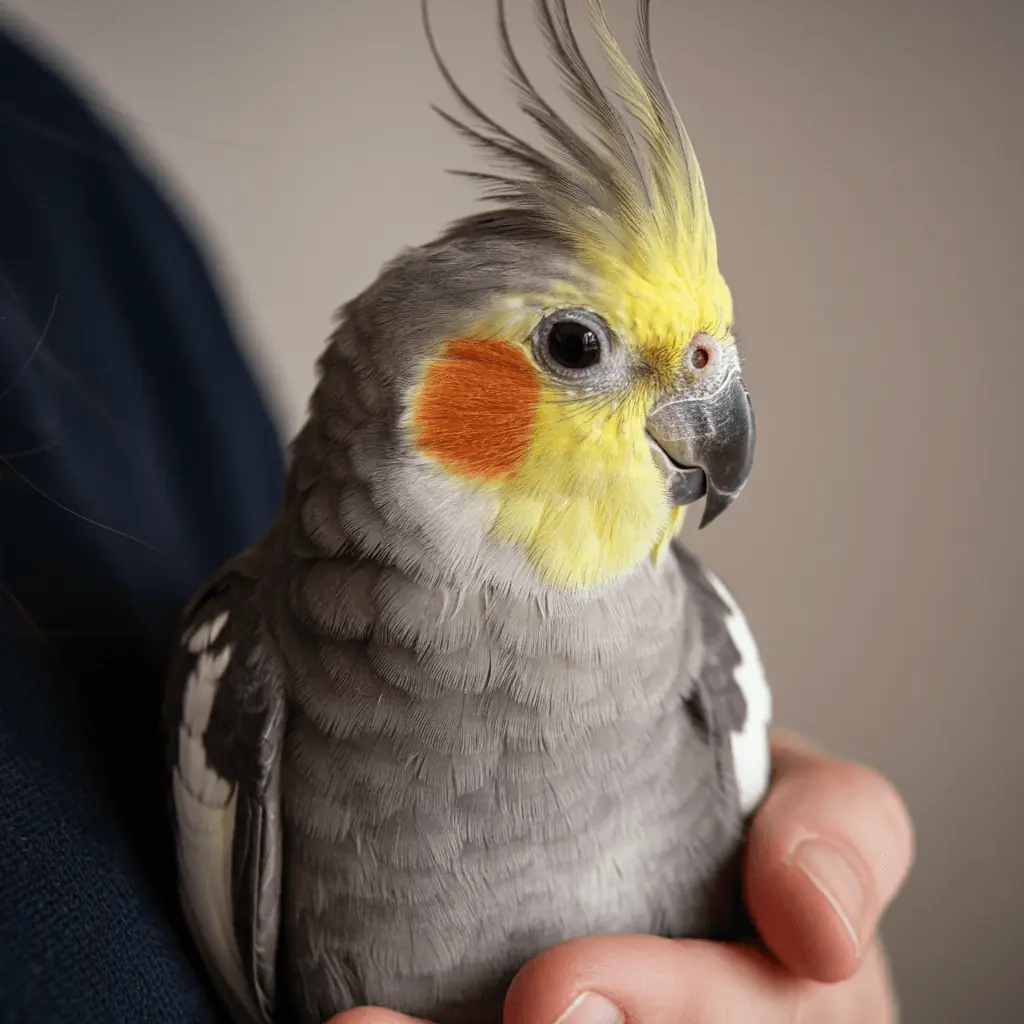
A cockatiel enjoys gentle handling from its owner during a grooming session, which builds trust and ensures the bird feels safe.
Essential Tools for Grooming Your Cockatiel
To properly groom your cockatiel, having the right tools on hand is key. With just a few essential grooming tools, you can ensure your bird stays healthy and comfortable without needing professional help. Here are the must-have tools for grooming your cockatiel at home:
- Nail Clippers
Cockatiel nails can grow too long, making it difficult for them to perch comfortably. A good pair of small bird nail clippers will allow you to safely trim your cockatiel’s nails without causing any discomfort. Be sure to use clippers designed for birds, as human nail clippers can cause damage. - Perch with Different Textures
Perches with varying textures not only give your bird a comfortable place to rest but also naturally help file down their nails. This minimizes how often you need to trim them and keeps their feet healthy. - Beak File or Cuticle Scissors
While cockatiels usually maintain their own beaks by chewing on toys or cuttlebones, sometimes their beak can grow too long or become uneven. In such cases, a beak file or even a set of small, gentle cuticle scissors can help you trim and shape it, ensuring your bird can eat and groom themselves easily. - Bird-Safe Spray Bath or Mist
Regular bathing is vital for keeping your cockatiel’s feathers clean and in good condition. A bird-safe spray bath or misting bottle is perfect for gently wetting your bird without stressing them out. You can also give your cockatiel the option of a shallow bath, but some birds prefer misting over soaking. - Styptic Powder
Accidents can happen, and if you trim your bird’s nails too short, they may bleed. Having styptic powder on hand is important as it quickly stops bleeding and prevents infection. It’s an essential backup for any grooming session. - Cuttlebone
A cuttlebone is essential not just for beak maintenance but also for calcium intake. Providing one in your bird’s cage ensures they can naturally file their beak while also benefiting their overall health.
With these essential grooming tools, you’ll be able to keep your cockatiel’s feathers, nails, and beak in excellent shape. Regular grooming not only improves their appearance but also ensures they stay healthy and comfortable, leading to a happier bird.
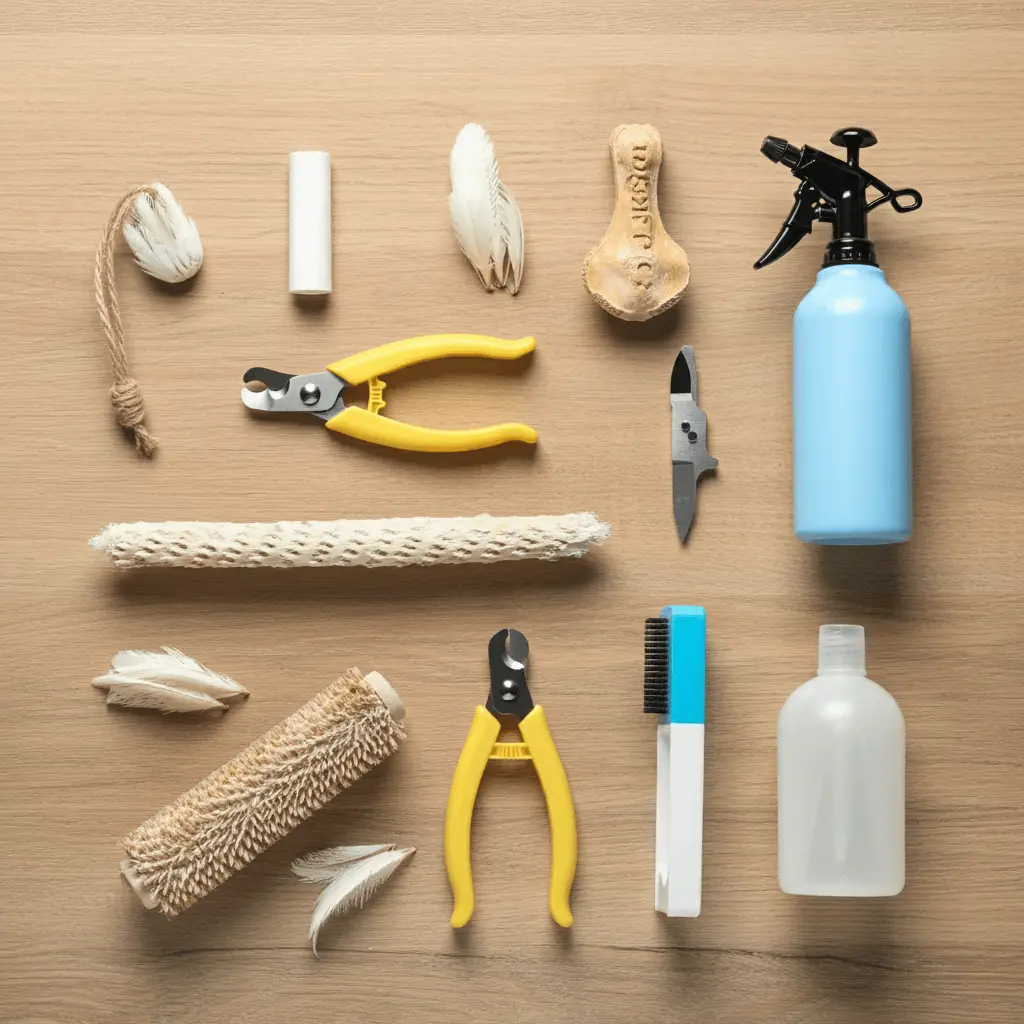
Essential cockatiel grooming tools, including nail clippers, perches, and sprays, laid out for a thorough grooming session.
How to Properly Bathe Your Cockatiel
Bathing is an important part of keeping your cockatiel’s feathers clean and healthy. Properly bathing your bird not only removes dirt and dust but also helps prevent issues like dry skin or feather mites. Fortunately, most cockatiels enjoy a bath, but it’s important to approach it the right way to avoid causing stress.
1. Choose the Right Time
The best time to bathe your cockatiel is during the day, when it’s warm and sunny. Cockatiels need time to dry off, and offering a bath when it’s too cold or late in the evening could make it difficult for them to dry their feathers properly, leading to discomfort or even illness.
2. Offer a Shallow Bath or Use a Mist Spray
There are two common methods for bathing cockatiels. You can offer a shallow dish of lukewarm water, allowing your bird to hop in and splash around on their own terms. Alternatively, you can use a bird-safe mist spray to gently wet their feathers. Both methods are effective, but some birds prefer misting over getting into the water.
3. Avoid Soaps and Shampoos
Cockatiels have sensitive skin and feathers, so never use soaps, shampoos, or any human grooming products on them. These can strip away the natural oils on their feathers, leading to dryness and irritation. Water alone is sufficient for keeping them clean.
4. Let Your Cockatiel Bathe on Their Terms
Some cockatiels love the water and will happily splash around, while others may be more hesitant. Let your bird decide how much they want to bathe, and don’t force them if they seem uncomfortable. If they enjoy the mist, give them a light spray and allow them to fluff up their feathers as they dry.
5. Drying Off
After the bath, it’s important to let your cockatiel dry off naturally. Place them in a warm, draft-free area where they can preen and fluff their feathers. If they seem a little cold, you can gently increase the room temperature, but never use a blow dryer, as the heat can be too intense and harmful to your bird.
Bathing your cockatiel properly helps maintain healthy feathers and skin while giving them a chance to engage in natural grooming behavior. Whether you choose a shallow dish or a mist spray, regular baths are a great way to keep your bird clean and happy. Just remember to be patient and let your cockatiel enjoy bath time at their own pace.
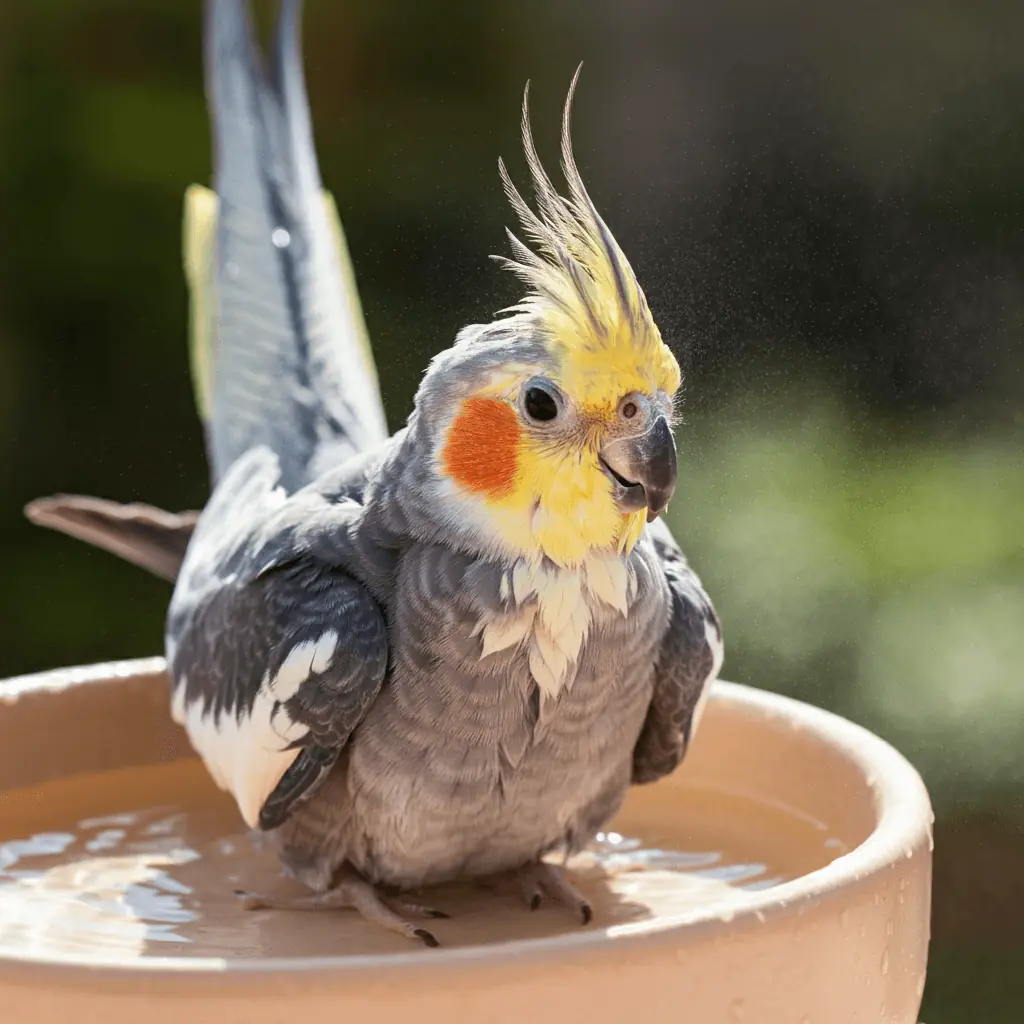
A cockatiel splashes in its bath, keeping its feathers clean and refreshed, an essential part of regular grooming.
Nail Trimming: Keeping Your Cockatiel’s Claws Healthy
Keeping your cockatiel’s nails trimmed is an essential part of maintaining their overall health and comfort. Overgrown nails can make it difficult for your bird to perch properly, leading to discomfort or even injuries. Regular nail trimming prevents these issues and ensures that your cockatiel can grip their perches without any trouble.
1. Know When to Trim
A cockatiel’s nails will grow continuously, and over time, they may become sharp or too long. If you notice your bird struggling to balance or see their nails curving too much, it’s likely time for a trim. Additionally, if your cockatiel’s nails start snagging on clothing or toys, that’s another clear sign they need to be clipped.
2. Use the Right Tools
When it comes to trimming your cockatiel’s nails, the right tools make all the difference. Use small bird nail clippers or specialized pet clippers designed for birds. These are safe and precise, allowing you to trim their nails without causing damage. Avoid using human nail clippers as they can split the nail or cut too deeply.
3. The Proper Trimming Technique
To trim your cockatiel’s nails safely, hold them gently but securely. Identify the quick—a vein that runs through the nail—and make sure you only trim the tip of the nail, well above this vein. Cutting the quick can cause bleeding and pain, so take care not to go too short.
If you’re new to trimming bird nails, it’s a good idea to have someone help hold your cockatiel steady while you trim. You can also ask a vet to demonstrate the process if you’re unsure.
4. What to Do If You Cut the Quick
Accidents can happen, and if you accidentally trim too far and cause bleeding, don’t panic. Styptic powder is a quick solution to stop the bleeding. Have some on hand during grooming sessions as a precaution.
5. Perch Choices to Help with Nail Maintenance
You can reduce how often you need to trim your cockatiel’s nails by offering a variety of textured perches. Natural wood or cement perches can help naturally file down your bird’s nails as they move around, keeping them at a healthy length between trimmings.
By regularly trimming your cockatiel’s nails and providing textured perches, you’ll prevent overgrown nails from causing discomfort or injury. Nail care is a simple but important part of cockatiel grooming that keeps your bird active and healthy, ensuring they can perch and explore comfortably.
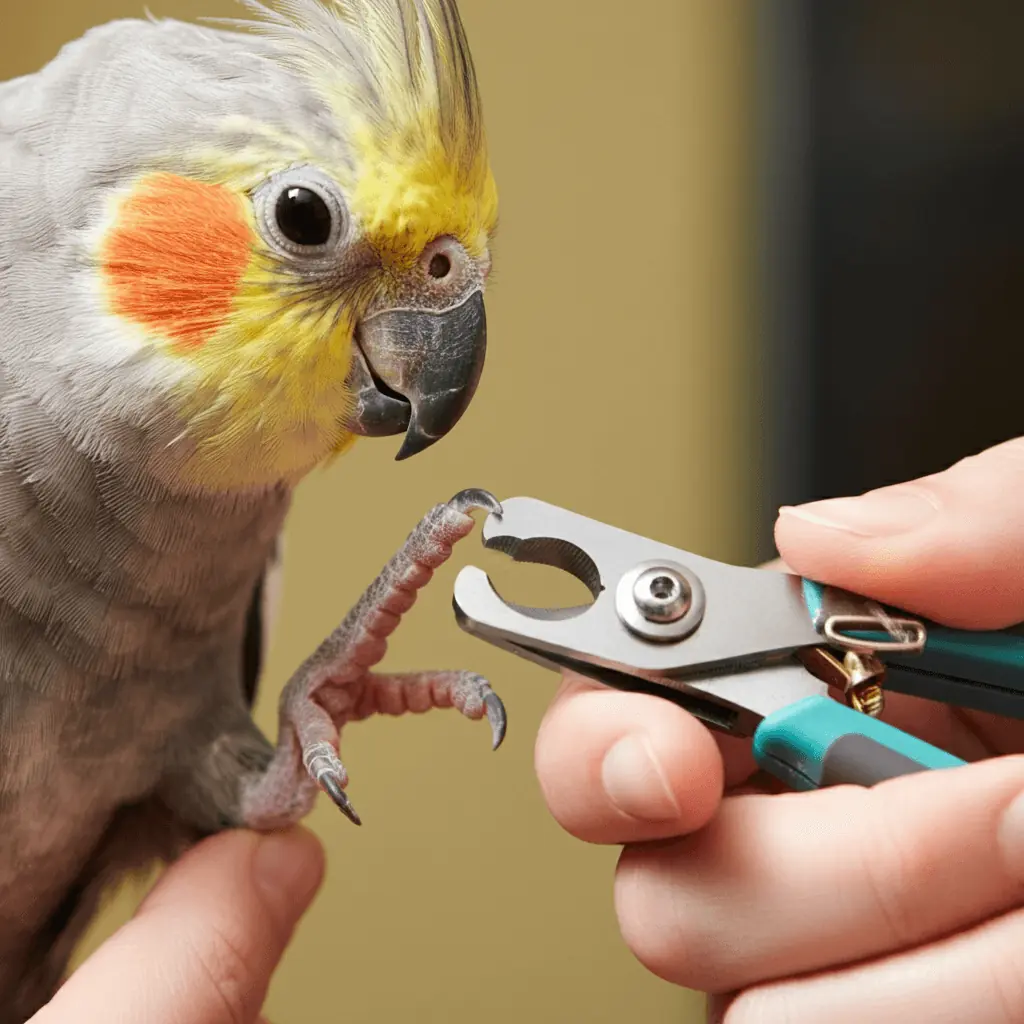
Nail care is an important part of cockatiel grooming, ensuring the bird’s nails are healthy and trimmed to a safe length.
Beak Maintenance: Ensuring Proper Beak Care
A cockatiel’s beak is an essential tool for eating, grooming, and exploring its environment. Keeping your cockatiel’s beak in good condition is crucial for their overall well-being. While cockatiels naturally wear down their beaks through chewing and foraging, regular monitoring and some basic care can prevent problems like overgrowth or misalignment.
1. Recognize the Signs of a Healthy Beak
A healthy cockatiel beak should be smooth, with no cracks or uneven ridges. The upper and lower parts of the beak should meet perfectly without overgrowing. If your cockatiel’s beak looks excessively long, chipped, or has difficulty closing, it’s a sign that it may need some attention.
2. Provide Natural Beak Trimming Tools
One of the simplest ways to ensure proper beak maintenance is by giving your cockatiel the right items to chew on. Cuttlebones, mineral blocks, and wooden toys are great options that allow your bird to file down their beak naturally. These items also provide essential nutrients, like calcium, which is good for their beak and bones.
3. Watch for Overgrown Beaks
Sometimes, a cockatiel’s beak may grow too long due to a lack of natural trimming or underlying health issues. If this happens, your bird may struggle to eat or groom properly. Overgrown beaks can be easily managed by a vet, who can trim them safely. It’s important not to attempt trimming the beak at home unless you’ve been trained to do so, as the beak has sensitive blood vessels and nerves.
4. Regular Beak Inspections
Just like with their nails, regularly inspecting your cockatiel’s beak is important to catch any issues early. Look for any signs of cracks, peeling, or overgrowth. If you notice any abnormalities, consulting an avian vet is the best course of action.
5. Beak Issues to Be Aware Of
Beak deformities, such as scissor beak (when the upper and lower parts of the beak don’t align) or beak infections, should be addressed immediately. These conditions can interfere with your cockatiel’s ability to eat and groom. If your bird’s beak looks abnormal or damaged, seek professional help right away.
By providing your cockatiel with the right items to chew on and keeping a close eye on their beak health, you can ensure proper beak maintenance and avoid common issues like overgrowth. A healthy beak is essential for your cockatiel’s overall well-being, helping them eat, groom, and interact with their environment comfortably.
Feather Care: How to Maintain a Healthy Plumage
Keeping your cockatiel’s feathers in top condition is crucial for their overall health and happiness. Feathers play a key role in insulation, flight, and protection, so proper feather care is essential. Maintaining healthy plumage requires a combination of regular grooming, a balanced diet, and an environment that encourages natural behaviors like preening.
1. Encourage Regular Preening
Cockatiels are naturally good at grooming themselves through preening. Preening allows them to remove dirt, dust, and old feathers, while redistributing natural oils that keep their plumage in good condition. Providing your cockatiel with time to preen, especially after a bath, helps ensure their feathers stay smooth and clean. If your bird appears to be over-preening or plucking feathers, this could signal stress or underlying health issues, and it’s worth consulting a vet.
2. Provide a Balanced Diet
Feather health is directly linked to your cockatiel’s nutrition. A balanced diet that includes high-quality pellets, fresh fruits, vegetables, and seeds ensures they get the vitamins and minerals necessary for strong, vibrant feathers. Nutrients like vitamin A and omega-3 fatty acids play an important role in maintaining healthy plumage, so be sure to include foods rich in these elements.
3. Offer Regular Baths
Bathing is essential for feather care. As mentioned earlier, a regular bath or misting helps remove dust and dirt from your cockatiel’s feathers while hydrating their skin. Whether you offer a shallow dish or mist your bird, ensuring they bathe regularly keeps their feathers clean and encourages healthy preening behavior.
4. Monitor Molting Cycles
Cockatiels go through natural molting cycles where they shed old feathers and grow new ones. It’s a normal process, but during this time, your bird may require extra care. Make sure they’re getting plenty of nutrients and offer them a bit more space and time to preen and rest. If molting seems excessive or if bald patches appear, it’s worth getting them checked by a vet to rule out any health concerns.
5. Keep Their Environment Clean
Feather health isn’t just about grooming—your cockatiel’s environment plays a big part too. A clean, dust-free cage helps reduce the buildup of particles that can dirty your bird’s feathers. Regular cage cleaning, including washing perches and toys, contributes to overall feather hygiene.
By following these feather care tips, you’ll help your cockatiel maintain a beautiful, healthy plumage. Ensuring that they have access to a balanced diet, regular baths, and a clean environment will keep their feathers strong, shiny, and well-maintained, contributing to their overall well-being.
Safe Ways to Trim Your Cockatiel’s Feathers
Feather trimming is a delicate process and should only be done if necessary. Some owners choose to trim their cockatiel’s flight feathers to prevent injury or accidental escapes, while others prefer to let their bird fly freely. If you decide to trim your cockatiel’s feathers, it’s important to do so safely and correctly to avoid harming your bird.
1. Know Which Feathers to Trim
When trimming your cockatiel’s feathers, only the primary flight feathers on each wing should be clipped. These are the long feathers at the end of the wing, which provide lift during flight. Be sure to leave enough feathers intact so your bird can still glide gently to the ground without crashing. Never trim all the feathers or clip too far up the wing, as this can cause your cockatiel to lose balance and potentially injure themselves.
2. Use the Right Tools
Using sharp, clean scissors specifically designed for feather trimming is crucial. Dull scissors can damage the feathers, making the trimming process uncomfortable or painful for your bird. It’s best to have a pair of grooming scissors with a blunt tip to avoid accidentally injuring your cockatiel during the trim.
3. Have a Professional Show You How
If you’re new to feather trimming, it’s highly recommended that you ask a vet or an experienced bird groomer to show you the proper technique first. Feather trimming can be tricky, and learning from a professional ensures that you don’t accidentally hurt your cockatiel or trim the wrong feathers.
4. Be Gentle and Calm
Handling your cockatiel during feather trimming should be done with care. Gently hold your bird, making sure they feel secure but not restricted. It’s important to keep your bird calm throughout the process to reduce stress. You may want to ask someone to help hold your cockatiel steady while you trim to make the process easier.
5. Trim in Small Steps
Instead of trimming all the feathers at once, you can cut one or two feathers at a time to gauge how well your cockatiel adjusts to the changes. This helps prevent over-clipping, allowing you to achieve just the right balance between flight control and safety. If you’re unsure, it’s better to trim less and check your bird’s flight ability before continuing.
6. Avoid Cutting Blood Feathers
Be extremely cautious of blood feathers, which are new feathers that still have a blood supply. Cutting a blood feather can cause significant bleeding and pain for your cockatiel. These feathers are usually darker in color or appear slightly swollen at the base, so always inspect the wings carefully before trimming.
Feather trimming can be a safe way to manage your cockatiel’s flight and prevent accidents, but it should always be done with care. If you’re not confident in your ability to trim your bird’s feathers, it’s best to seek help from a professional groomer or avian vet. This ensures your cockatiel’s well-being and allows them to remain safe and comfortable while adjusting to the trimmed feathers.
Maintaining a Clean Cage for Optimal Hygiene
A clean cage is essential for your cockatiel’s health and well-being. Cockatiels spend most of their time in their cage, and without regular cleaning, harmful bacteria, mold, and debris can accumulate, potentially leading to health issues. By maintaining a clean environment, you help ensure your bird stays healthy and happy.
1. Clean the Cage Daily
Cleaning your cockatiel’s cage doesn’t have to be a time-consuming task. A quick daily spot clean can go a long way. Remove any leftover food, droppings, and feathers from the cage floor. Wipe down the perches, toys, and food dishes to prevent bacteria buildup. This simple routine ensures your cockatiel’s living space remains hygienic between deeper cleanings.
2. Deep Clean Weekly
In addition to daily spot cleaning, a more thorough cleaning should be done at least once a week. Remove your cockatiel from the cage and take out all accessories, including perches, toys, and food bowls. Wash everything with warm water and mild soap, making sure to rinse well to remove any soap residue. Scrub down the cage bars, tray, and corners where dirt tends to build up. After cleaning, allow everything to dry completely before placing your bird back in the cage.
3. Use Safe Cleaning Products
When cleaning your cockatiel’s cage, it’s important to use bird-safe cleaning products. Avoid harsh chemicals like bleach or ammonia, which can release harmful fumes and irritate your bird’s respiratory system. Opt for a natural or mild cleaner, or even a simple vinegar and water solution, which is safe and effective for disinfecting the cage.
4. Change Cage Liners Regularly
Cage liners or paper towels should be changed every day to prevent the buildup of droppings and food debris. Clean cage liners not only help with odor control but also make it easier to monitor your cockatiel’s health by spotting any abnormalities in their droppings.
5. Keep Food and Water Dishes Clean
Cockatiels are messy eaters, and leftover food can quickly become moldy if left in the cage for too long. Clean and refill food and water dishes daily to prevent contamination. Make sure to scrub the bowls thoroughly to remove any stuck-on food, which can harbor bacteria.
6. Monitor for Pests
A dirty cage can attract unwanted pests like ants, mites, or flies, which can harm your cockatiel. Regular cleaning helps keep these pests at bay. If you notice any signs of mites or other infestations, such as excessive scratching or feather loss, consult an avian vet immediately and deep clean the cage thoroughly.
Maintaining a clean cage not only provides a hygienic environment for your cockatiel but also contributes to their overall happiness. A clean space encourages natural behaviors like preening and playing, reducing stress and improving your bird’s quality of life. By staying on top of daily and weekly cleaning routines, you ensure that your cockatiel has a safe, comfortable, and healthy home.
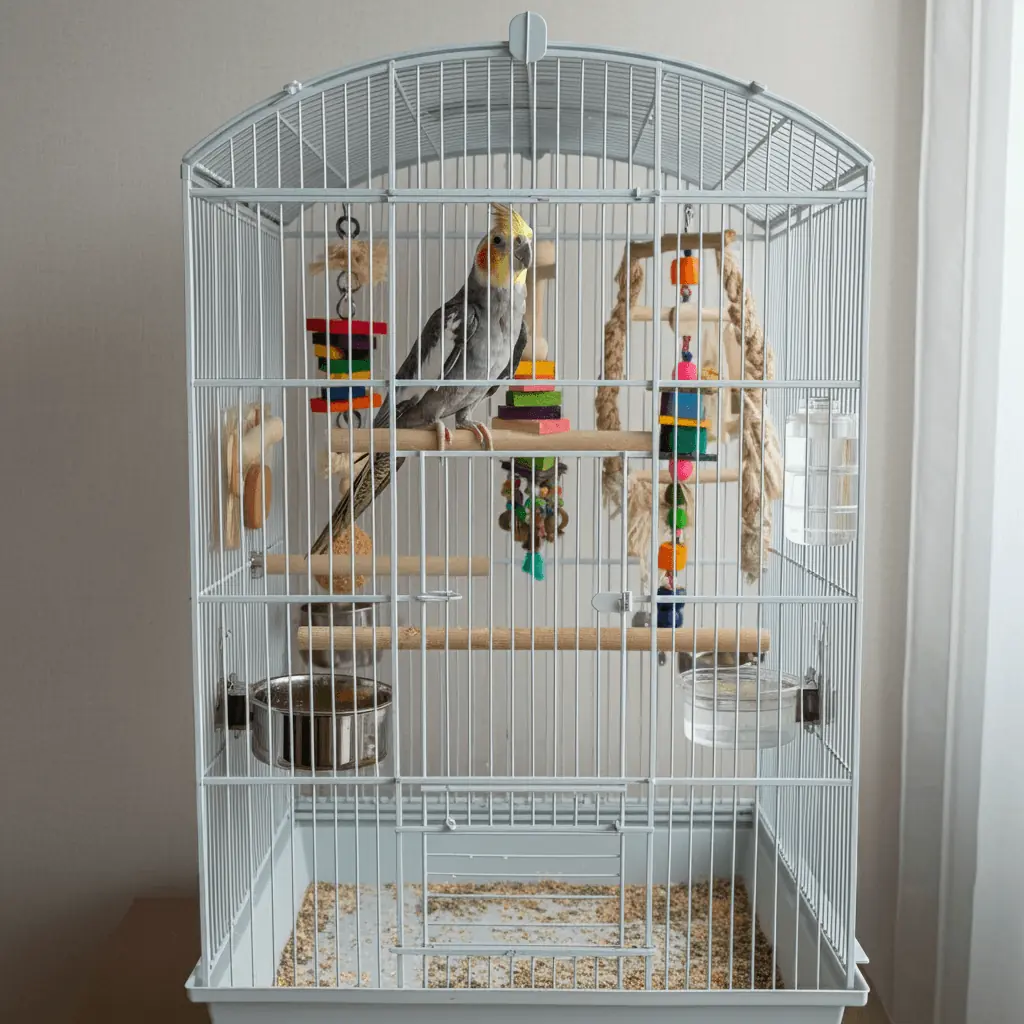
A hygienic cage setup is vital to your cockatiel’s health and happiness, ensuring a clean living environment for your bird.
Common Grooming Mistakes to Avoid
While grooming your cockatiel is essential for their health and happiness, there are a few common mistakes that owners often make, especially if they’re new to bird care. Avoiding these mistakes will help ensure that your cockatiel stays safe, comfortable, and well-groomed.
1. Over-Trimming Feathers
One of the most common mistakes is over-trimming your cockatiel’s flight feathers. Cutting too many feathers or trimming too close to the body can hinder your bird’s ability to glide safely to the ground, increasing the risk of injury. Always trim only the primary flight feathers and leave enough for your bird to maintain balance and gentle control when moving around.
2. Using the Wrong Tools
Using improper tools for grooming, like human nail clippers or dull scissors, can cause harm to your cockatiel. Bird-specific grooming tools, such as small nail clippers and bird-safe scissors, are designed for your pet’s delicate needs. Using the right equipment ensures a safe and comfortable grooming experience.
3. Ignoring the Quick When Trimming Nails
Accidentally cutting into the quick—the blood vessel inside the nail—is a painful mistake for your bird. Always trim the tips of the nails, far from the quick, to avoid causing bleeding and discomfort. If you’re unsure, start with a very small trim and work your way up, or consult a vet for guidance.
4. Bathing Too Infrequently
Some owners may bathe their cockatiel too infrequently, leading to dirty feathers and potential skin issues. Cockatiels need regular baths or misting to keep their feathers clean and healthy. Offering your bird a bath once or twice a week encourages natural grooming behavior and helps maintain a vibrant plumage.
5. Using Harsh Cleaning Products
When cleaning your bird’s cage or grooming tools, avoid using harsh chemicals like bleach or disinfectants that aren’t bird-safe. These can release harmful fumes that could irritate your cockatiel’s respiratory system. Stick to mild, bird-safe cleaners or natural solutions like vinegar and water.
6. Neglecting Beak Care
Beak care is often overlooked, but it’s a critical part of cockatiel grooming. Providing toys, cuttlebones, and mineral blocks allows your bird to naturally maintain their beak. If your cockatiel’s beak becomes overgrown or misaligned, it’s important to consult a vet for proper trimming.
7. Not Monitoring for Stress
Grooming sessions can be stressful for some birds, especially if they aren’t used to being handled regularly. Watch for signs of stress, such as rapid breathing, excessive squawking, or aggressive behavior. If your cockatiel seems overly anxious, try to break grooming tasks into shorter, more manageable sessions to keep them calm.
By avoiding these common grooming mistakes, you’ll ensure that your cockatiel stays healthy, comfortable, and well-groomed. Proper grooming not only benefits their physical health but also strengthens your bond with your bird, making them happier and more trusting over time.
FAQs About Cockatiel Grooming
1. How often should I bathe my cockatiel?
Cockatiels typically enjoy a bath once or twice a week, though some may prefer more frequent baths. It’s important to offer your bird the option to bathe regularly, as this helps maintain healthy feathers and skin. Whether you use a shallow dish or misting bottle, bathing is a key part of keeping your cockatiel clean.
2. Do I need to trim my cockatiel’s nails?
Yes, regular nail trimming is important to prevent overgrown nails, which can make it difficult for your bird to perch comfortably. If your cockatiel’s nails start getting too long or sharp, it’s time for a trim. Use bird-safe nail clippers and avoid cutting too close to the quick to prevent bleeding.
3. Can I trim my cockatiel’s feathers at home?
You can trim your cockatiel’s feathers at home, but it’s recommended to learn from a vet or professional groomer first. Only trim the primary flight feathers and be careful not to cut too much. If you’re unsure, it’s always safer to seek help from a professional.
4. How do I know if my cockatiel’s beak needs trimming?
A cockatiel’s beak should be smooth and align properly. If it starts to look too long, cracked, or uneven, it may require trimming. Most cockatiels maintain their beaks naturally by chewing on toys and cuttlebones. If you notice any issues with the beak, consult a vet for safe trimming.
5. What tools do I need for cockatiel grooming?
Essential grooming tools for your cockatiel include bird nail clippers, a cuttlebone or mineral block for beak maintenance, a bird-safe misting spray for baths, and styptic powder in case of accidental bleeding during nail trimming. Providing perches with different textures can also help maintain nails and beak naturally.
6. Is it okay to use soap when bathing my cockatiel?
No, you should never use soap or shampoo when bathing your cockatiel. Their feathers are delicate and using soaps can strip them of their natural oils, leading to dryness and irritation. Plain water is enough to keep them clean and healthy.
7. How can I prevent feather plucking in my cockatiel?
Feather plucking can be caused by stress, boredom, or underlying health issues. Ensure your cockatiel has plenty of toys, a clean and engaging environment, and regular social interaction. If the plucking persists, consult a vet to rule out any health problems.
By understanding the basics of cockatiel grooming, you can help your bird stay healthy, happy, and well-groomed. Proper grooming is an important part of maintaining your cockatiel’s overall well-being and strengthens the bond between you and your feathered friend.
Conclusion: Keeping Your Cockatiel Clean and Healthy
Grooming your cockatiel is more than just a routine—it’s an essential part of maintaining their overall health and well-being. From regular feather care to trimming nails and keeping their cage clean, each aspect of grooming contributes to your cockatiel’s comfort, health, and happiness. A well-groomed bird not only looks and feels better, but it also reduces the risk of health issues such as overgrown nails, beak problems, and dirty feathers.
By providing your cockatiel with regular baths, ensuring their nails and beak are properly maintained, and keeping their living space clean, you’re setting the foundation for a long, happy life. Remember, grooming also gives you an opportunity to bond with your bird and monitor their overall health, allowing you to catch any potential problems early.
Incorporating these grooming essentials into your routine will help ensure that your cockatiel stays clean, healthy, and comfortable, making them a happier companion for years to come. Whether you’re a new bird owner or experienced with cockatiels, regular grooming is a simple yet powerful way to keep your feathered friend in top shape.

